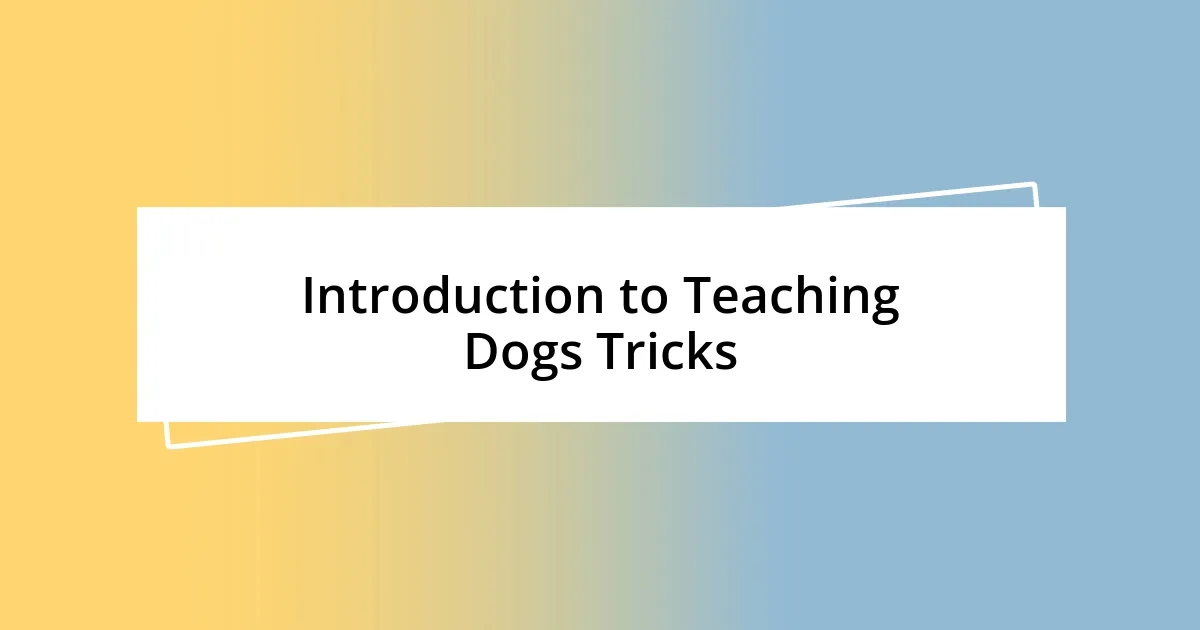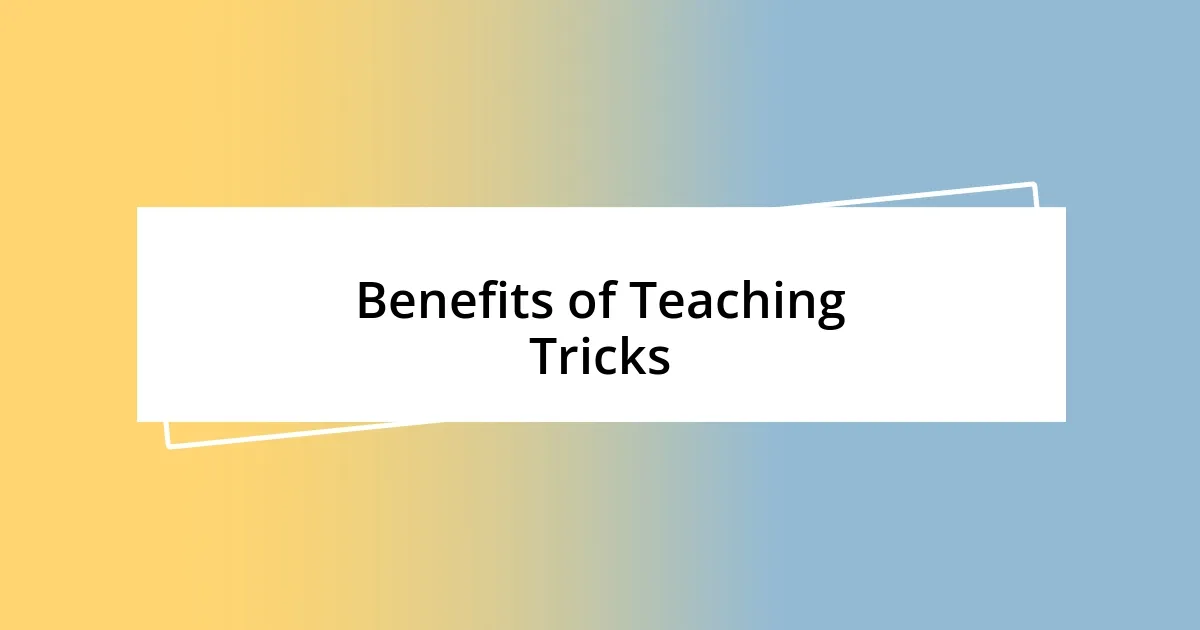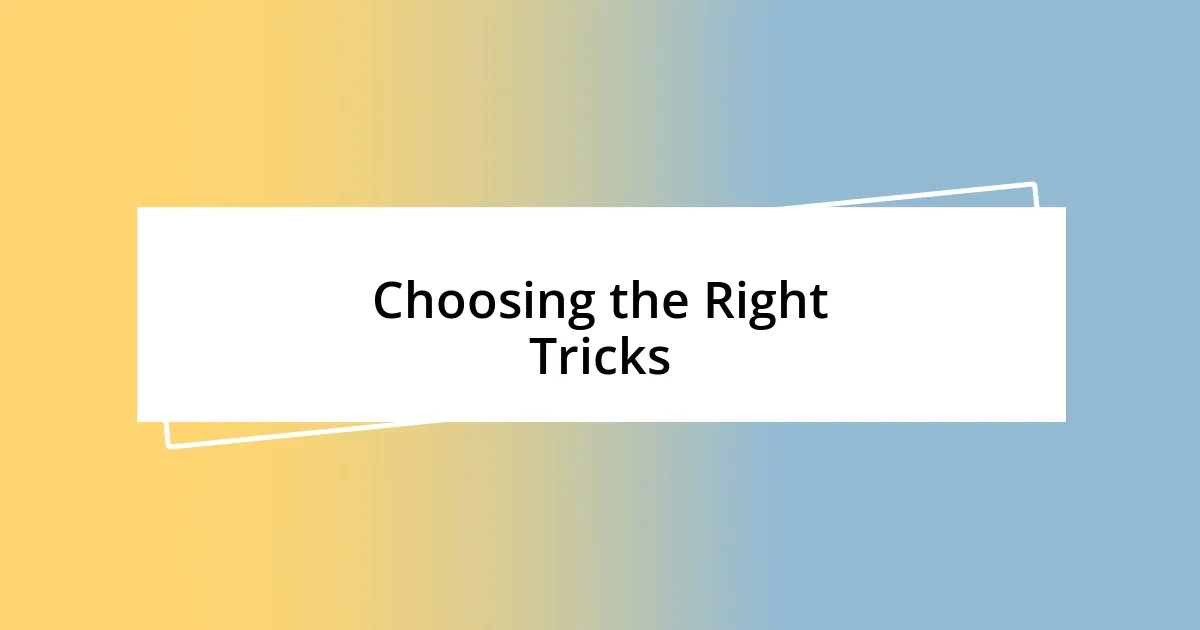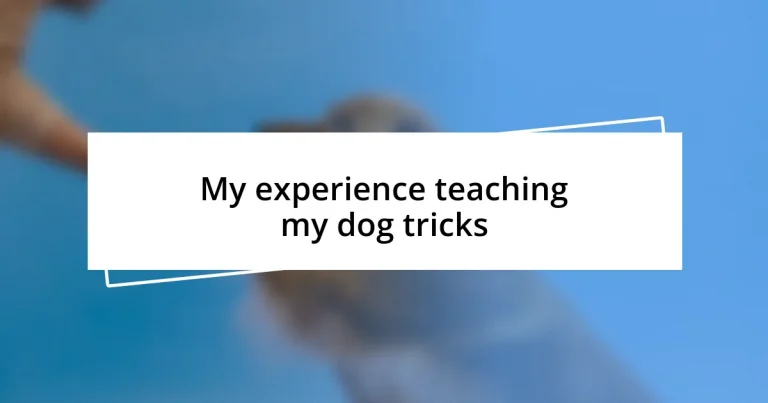Key takeaways:
- Teaching dogs tricks enhances the bond between the owner and the pet through teamwork, communication, and shared achievements.
- Positive reinforcement, such as treats and praise, is essential for motivating dogs and strengthening their understanding of commands.
- Choosing the right tricks based on a dog’s personality and starting with simple commands creates an engaging and effective training experience.
- Overcoming challenges like distractions and variable enthusiasm requires patience and adaptability in training methods.

Introduction to Teaching Dogs Tricks
Teaching dogs tricks can be one of the most rewarding experiences for both the owner and the pet. I remember the first time I taught my dog to shake hands; he looked at me with those eager eyes, as if saying, “What’s next?” There’s something truly special about seeing a dog’s excitement when they realize they’re learning a new skill.
Have you ever thought about how teaching tricks can strengthen the bond between you and your dog? Each time I worked with my pup, it felt like we were communicating on a deeper level. It was more than just commands and responses; it was about understanding each other’s cues and building trust. Tricks aren’t just for fun; they can enhance a dog’s confidence and foster a sense of accomplishment.
With patience, consistency, and a sprinkle of creativity, anyone can teach a dog new tricks. I found that breaking down each command into small, manageable steps made the learning process smoother for my furry friend. It’s amazing how small successes lead to bigger ones, creating a fun learning journey filled with laughter and joy. How have your experiences been with teaching your dog? Each moment is a step towards a stronger connection.

Benefits of Teaching Tricks
Teaching tricks can transform your relationship with your dog by instilling a sense of teamwork and cooperation. I’ll never forget the day my dog finally mastered the roll-over trick. It felt like we had celebrated a huge victory together! This shared sense of achievement not only boosted his confidence but also deepened our connection as we cheered for each other’s successes.
Moreover, teaching tricks can provide excellent mental stimulation for dogs. Engaging their minds helps reduce boredom and destructive behaviors. I noticed a significant reduction in my dog’s anxious habits during training sessions. His focus during trick practice was invigorating – I could see he was a happy dog, eager to learn and pleased to participate.
And let’s not overlook the physical activity involved! Teaching tricks isn’t just about learning; it’s also a fun way to get some exercise together. I loved watching my pup wiggle and jump around with excitement as he tried to figure out what I wanted him to do. It became a delightful bonding time filled with laughter and joyful movement.
| Benefit | Description |
|---|---|
| Strengthened Bond | Teaching tricks fosters teamwork and communication, enhancing emotional connections. |
| Mental Stimulation | Engaging your dog’s mind helps prevent boredom and reduces behavioral issues. |
| Physical Activity | Learning tricks involves movement, providing a fun way to exercise together. |

Choosing the Right Tricks
Choosing the right tricks to teach your dog can greatly impact their learning journey and your experience together. I remember when I first decided on a trick to teach my dog: I wanted something both fun and practical. I ended up picking “spin” because it was visually entertaining and provided a good workout. The joy on my dog’s face when he finally got it was priceless—it’s moments like these that make you appreciate the bond developing between you.
Here are some tips to help you decide on the best tricks for your pup:
-
Consider their personality: Choose tricks that suit your dog’s natural strengths or quirks. For instance, if your dog loves to jump, tricks like “jump through a hoop” might be a good fit.
-
Focus on usefulness: Tricks that can serve everyday purposes, like “fetch” or “stay”, can be both fun and practical.
-
Start simple: Begin with easier tricks to build confidence. As your dog masters these, you can gradually take on more complex commands.
By keeping all this in mind, you’ll set yourself and your dog up for a fun, engaging, and fulfilling training experience.

Essential Training Tools Needed
When it comes to training my dog, having the right tools makes a significant difference. I found that a high-value treat pouch was essential—it keeps my hands free while rewarding good behavior. Remember that moment when my dog, eyes wide with eagerness, would sit still just to earn that delicious treat? It’s a bonding experience like no other, as he learns to associate positive actions with rewards.
Another invaluable tool is a clicker. This small device produces a distinct sound that marks the exact moment my dog does something right. I still chuckle when I think about the first time I used it. My dog looked confused, then thrilled as he realized that the click meant he had done something fantastic! Using a clicker added clarity to our training sessions, allowing me to communicate my approval more effectively.
Lastly, don’t underestimate the power of patience and consistency. I always make sure to have a training schedule and stick to it. There were days when my dog struggled with a trick, and I felt a mixture of frustration and determination. But I learned that taking breaks and returning with fresh energy was often more beneficial. In those moments of struggle, I found both my dog and I grew stronger, reinforcing our bond through our shared commitment to learning together.

Positive Reinforcement Techniques
While teaching my dog a new trick, I quickly realized the power of positive reinforcement. For every little success—whether it was just approaching the target spot or actually performing the trick—I would shower him with praise and a tasty treat. It’s fascinating how something as simple as a genuine “Good boy!” can light up his face; that joy is contagious and drives both of us to keep pushing forward.
I also found that timing is everything. When I first started using the clicker, I wasn’t sure if it would really make a difference. But the moment I clicked as my dog completed a trick, it was like a light bulb went off for him. He learned to connect the sound with his action, and I can still recall the look of realization on his face! It was a remarkable moment that not only boosted his confidence but also strengthened our communication. Have you ever seen that spark when a dog understands what you want? It truly is rewarding!
Additionally, I’ve learned that mixing up the rewards can keep my dog’s enthusiasm alive. Sometimes I use his favorite treats, and other times, it’s a game of tug or a quick play session. This variety keeps him engaged, preventing training from becoming monotonous. Don’t you think it’s beautiful how simple adjustments can lead to more excitement in learning? After all, making the process as fun as possible for both of us is key to mastering those tricks together!

Common Challenges and Solutions
One common challenge I faced while teaching my dog tricks was his occasional distraction. Picture this: one moment he’s perfectly focused, and the next, something outside catches his eye. I realized that setting a controlled environment for training sessions helped immensely. Reducing distractions, like training indoors or in a quiet backyard, allowed him to concentrate better and made our time together much more productive.
Another hurdle was the frustration of repeating the same command without success. I distinctly remember when my dog just wouldn’t grasp the “roll over” command. I felt perplexed and a bit defeated. I discovered that breaking the trick into smaller steps made all the difference. Instead of overwhelming him with the entire trick at once, I taught him to lie down first, then to turn his body a little, and finally to roll over. What if I hadn’t given him that extra patience and time? I think of how unnecessary stress could have derailed our progress entirely.
Lastly, I encountered the challenge of variable enthusiasm—a real rollercoaster! Some days he was eager and playful, while other days he seemed apathetic. It struck me that recognizing these mood swings was key. When he was less interested, I would shift our training to shorter sessions filled with play breaks or even incorporate fun games to reignite his enthusiasm. Have you noticed how a little shift in approach can turn a tough day into a delightful experience? Finding that balance made our training sessions much more enjoyable and effective.

Celebrating Your Dog’s Progress
Celebrating your dog’s progress is one of the most rewarding aspects of training. I remember the first time my pup successfully performed a trick he had been struggling with for a week. When he got it right, I felt this rush of joy wash over me. As I cheered and offered him a treat, I could see a sense of pride blossoming in his eyes. It’s moments like these that create a deep bond between us, reminding me why I embarked on this journey in the first place.
A small celebration can make a big difference in your training. After every successful trick, I’ve made it a habit to have a little dance party in the living room—nothing too fancy, just some fun moves with my dog. His tail wagging and playful barks bring a smile to my face. Have you ever thought about celebrating your dog’s small wins this way? Sometimes, it’s the festive spirit that keeps both of us inspired to continue learning.
Don’t underestimate the power of tracking progress, either. I started keeping a simple journal of the tricks he mastered, noting dates and little milestones. Looking back at those entries fills me with pride, and it’s a fantastic way to reflect on how far we’ve come. Have you considered doing something similar? It can be a real motivational boost when you see concrete evidence of your dog’s success!














